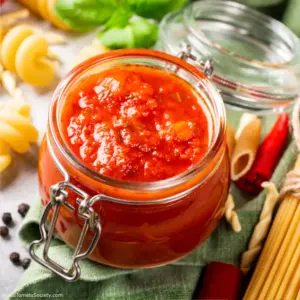 Tomato purée is the basis of many dishes without which a true tomato fan cannot imagine his life. Soups, sauces, pasta dishes, rice dishes, or stews. But how to quickly make a good tomato purée? Years back there weren’t electric gadgets to help in the kitchen and everything was done by hand. Today, kitchen mixers and blenders make things very easy. However, both then and today, there were and are many ways to prepare tomato purée. Some people mix raw tomatoes with seeds and skins and then heat up and cook the purée. Sometimes they pour the purée through a sieve for better consistency and smoothness, and sometimes not. Others prefer to get rid of the skins and seeds first, then cook the tomatoes, and finally put everything through a sieve. Some people use hand-operated fruit puréers and cook the tomato purée. Whichever method we choose, the result is a delicious product that we can enjoy all year round after pasteurizing or freezing.
Tomato purée is the basis of many dishes without which a true tomato fan cannot imagine his life. Soups, sauces, pasta dishes, rice dishes, or stews. But how to quickly make a good tomato purée? Years back there weren’t electric gadgets to help in the kitchen and everything was done by hand. Today, kitchen mixers and blenders make things very easy. However, both then and today, there were and are many ways to prepare tomato purée. Some people mix raw tomatoes with seeds and skins and then heat up and cook the purée. Sometimes they pour the purée through a sieve for better consistency and smoothness, and sometimes not. Others prefer to get rid of the skins and seeds first, then cook the tomatoes, and finally put everything through a sieve. Some people use hand-operated fruit puréers and cook the tomato purée. Whichever method we choose, the result is a delicious product that we can enjoy all year round after pasteurizing or freezing.
The fastest way to prepare tomato purée is to wash fresh, ripe tomatoes*, blend them whole in a blender or food processor, and then cook them until the purée is the right consistency. Any tomato variety can be used for purée, but the best results are obtained by selecting varieties with paste-type fruit, with a low content of seeds and gel, and with thick, fleshy walls. While the purée is cooking, you can add salt and sugar to taste. You can also prepare different flavors by adding fresh or dried herbs or garlic while mixing.
The purée prepared in this way can be used immediately as a base for a delicious sauce for pasta, soup, or stews, but it can also be canned for the winter in jars or bottles or frozen in freezer-proof containers.
* You can use any tomato varieties you like. Remember, that if you use paste-type tomatoes like San Marzano or Roma, or very meaty ox-hearts and beefsteaks, you will get thicker purée.
Dorota Basiura
World Tomato Society Website Content Director
Readers Comments